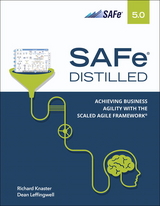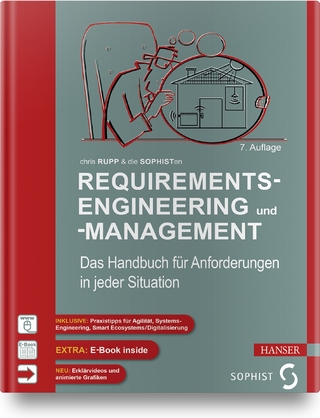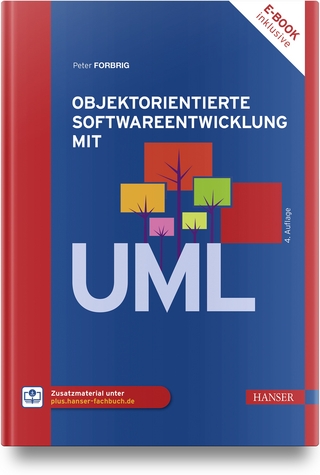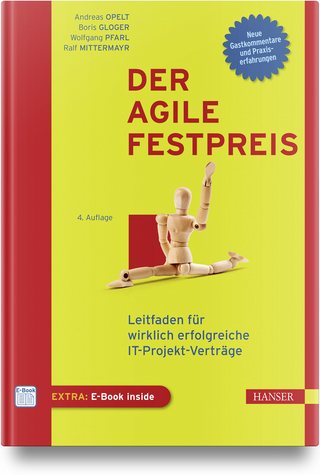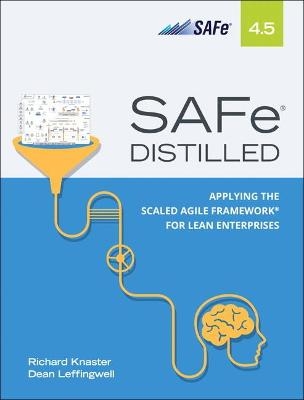
SAFe 4.5 Distilled
Addison Wesley (Verlag)
978-0-13-517049-6 (ISBN)
- Titel erscheint in neuer Auflage
- Artikel merken
“Philips is continuously driving to develop high-quality software in a predictable, fast, and Agile way. SAFe addresses this primary goal, and offers these further benefits: reduced time-to-market, improved quality, stronger alignment across geographically distributed multi-disciplinary teams, and collaboration across teams to deliver meaningful value to customers with reduced cycle time.”
—Sundaresan Jagadeesan, SW CoE Program Director, Philips
To succeed in today’s adapt-or-die marketplace, businesses must be able to rapidly change the way they create and deliver value to their customers. Hundreds of the world’s most successful companies–including Intel, Capital One, AstraZeneca, Cisco, and Philips–have turned to the Scaled Agile Framework® (SAFe®) to achieve agility at scale and maintain a competitive edge.
SAFe® 4.5 Distilled: Applying the Scaled Agile Framework® for Lean Enterprises explains how adopting SAFe can quickly improve time to market and increase productivity, quality, and employee engagement. In this book, you will
Understand the business case for SAFe: its benefits, the problems it solves, and how to apply it
Get an overview of SAFe across all parts of the business: team, program, value stream, and portfolio
Learn why SAFe works: the power of SAFe’s Lean-Agile mindset, values, and principles
Discover how systems thinking, Agile development, and Lean product development form the underlying basis for SAFe
Learn how to become a Lean-Agile leader and effectively drive an enterprise-wide transformation
Register your book for convenient access to downloads, updates, and/or corrections as they become available. See inside book for details.
Richard Knaster, SAFe Fellow and Principal Consultant at Scaled Agile, Inc., has more than 25 years’ experience in software development in roles ranging from developer to executive and has been involved in Agile for more than a decade. Prior to joining Scaled Agile, Inc., Richard worked at IBM, where his career spanned from product line management (PPM domain) and professional services to chief methodologist, Agile and Lean. Richard is a certified IBM Thought Leader and an Open Group Distinguished IT Specialist. He is also a certified SPC, PSM, Agile Certified Practitioner, PMP, and a contributor to the Disciplined Agile Delivery framework and PMI Portfolio/Program Management standards. He is a contributor to SAFe® 4.5 Reference Guide (Addison-Wesley, 2018). Dean Leffingwell, creator of SAFe®, is widely recognized as the one of the world’s foremost authorities on Lean-Agile best practices. He is an author, serial entrepreneur, and software systems development methodologist. His two best-selling books, Agile Software Requirements: Lean Requirements Practices for Teams, Programs, and the Enterprise (Addison-Wesley, 2011), and Scaling Software Agility: Best Practices for Large Enterprises (Addison-Wesley, 2007), form much of the basis of modern thinking on Lean-Agile practices and principles.
Preface xiii
Acknowledgments xix
About the Authors xxi
Abbreviations Used in This Book xxiii
Part I: Overview 1
Chapter 1: Business Need for SAFe 3
Why Do Businesses Need SAFe? 3
The Challenge of System Development 4
Applying New Bodies of Knowledge 5
Improving System Development Outcomes 8
The Business Benefits of SAFe 9
Summary 12
Chapter 2: SAFe Overview 13
The Big Picture 13
The Configurations 14
The Spanning Palette 23
The Foundation 24
Summary 26
Part II: Mindset, Principles, and Leadership 27
Chapter 3: Lean-Agile Mindset 29
Overview 29
Thinking Lean 30
Applying the Agile Manifesto at Scale 37
Summary 40
Chapter 4: SAFe Principles 41
Why Focus on Principles? 41
Principle #1: Take an Economic View 42
Principle #2: Apply Systems Thinking 47
Principle #3: Assume Variability; Preserve Options 50
Principle #4: Build Incrementally with Fast, Integrated Learning Cycles 51
Principle #5: Base Milestones on Objective Evaluation of Working Systems 53
Principle #6: Visualize and Limit WIP, Reduce Batch Sizes, and Manage Queue Lengths 55
Principle #7: Apply Cadence; Synchronize with Cross-Domain Planning 58
Principle #8: Unlock the Intrinsic Motivation of Knowledge Workers 61
Principle #9: Decentralize Decision-Making 63
Summary 64
Chapter 5: Lean-Agile Leaders 65
Exhibit the Lean-Agile Mindset 65
Lead the Change 66
Know the Way and Emphasize Lifelong Learning 66
Develop People 67
Inspire and Align with Mission. Minimize Constraints 70
Decentralize Decision-Making 71
Unlock the Intrinsic Motivation of Knowledge Workers 71
Evolve the Development Manager Role 71
Adopt a Servant-Leadership Approach 72
Evolve the Partnership with Human Resources Management 73
On the Future of Leadership 74
Summary 75
Part III: Essential SAFe 77
Chapter 6: The Agile Release Train 79
Overview 79
ART Organization 80
Develop on Cadence. Release on Demand 83
Vision 85
Features 85
Program Backlog 87
Roadmap 87
Agile Teams Power the Train 88
User Stories and the Team Backlog 90
Summary 94
Chapter 7: Planning a Program Increment 95
Overview 95
Preparation for the PI Planning Event 96
Day 1: Create and Review Draft Plans 99
Day 2: Finalize Plans and Commit 104
Summary 112
Chapter 8: Iterating 113
Overview 113
The Iteration Cycle 114
Building Quality In 120
Improving Team Flow with Kanban 123
Summary 127
Chapter 9: Executing the Program Increment 129
Overview 129
Introducing the Continuous Delivery Pipeline 129
Enabling Continuous Delivery with DevOps 137
Enabling Continuous Delivery with Architectural Runway 139
Managing Continuous Delivery with the Program Kanban 140
Supporting Continuous Delivery with Program Events 141
Summary 144
Chapter 10: Inspect and Adapt 145
Overview 145
PI System Demo 146
Quantitative Measurement 146
Retrospective and Problem-Solving Workshop 148
Inspect and Adapt at the Large Solution Level 151
Summary 152
Part IV: Large Solution SAFe 153
Chapter 11: Large Solution SAFe Overview 155
Overview 155
The Solution Train 156
Solution Intent 157
Capabilities and the Solution Backlog 158
Solution Epics 160
Economic Framework 160
Applying Large Solution Elements to Other Configurations 162
Summary 163
Chapter 12: Defining Large and Complex Solutions 165
Overview 165
The Solution 166
Solution Intent 167
Solution Context 171
Summary 174
Chapter 13: Solution Train Execution 177
Overview 177
Pre-PI Planning 178
ART PI Planning 179
Post-PI Planning 180
Frequent Solution Integration 182
Solution Train Sync 182
Solution Demo 183
Solution Train Inspect and Adapt 183
Summary 184
Part V: Portfolio SAFe 185
Chapter 14: Lean Portfolio Management 187
Introduction 187
Strategy and Investment Funding 188
Agile Portfolio Operations 190
Lean Governance 192
Summary 193
Chapter 15: Strategy and Investment Funding 195
Introduction 195
Connect the Portfolio Strategy to the Enterprise Strategy 196
Establish Portfolio Flow 204
Summary 209
Chapter 16: Agile Portfolio Operations 211
Introduction 211
Support an Agile PMO, LACE, and RTE and Scrum Master Communities of Practice 212
Coordinate Value Streams 216
Sustain and Improve 219
Summary 219
Chapter 17: Lean Governance 221
Introduction 221
Forecast and Budget Dynamically 222
Measure Portfolio Performance 224
Capitalization of Agile Software Development 226
Governance via Agile Contracts 228
Coordinate Continuous Compliance 231
Summary 231
Part VI: Implementing SAFe 233
Chapter 18: The Guiding Coalition 237
Introduction 237
Step 1. Reach the Tipping Point 238
Step 2. Train Lean-Agile Change Agents 240
Step 3. Train Executives, Managers, and Leaders 240
Step 4. Create a Lean-Agile Center of Excellence 241
Summary 242
Chapter 19: Designing the Implementation 243
Introduction 243
Step 5. Identify Value Streams and Agile Release Trains 243
Step 6. Create the Implementation Plan 251
Summary 254
Chapter 20: Implementing Agile Release Trains 255
Introduction 255
Step 7. Prepare for the ART Launch 255
Step 8. Train Teams and Launch the ART 262
Step 9. Coaching ART Execution 264
Summary 266
Chapter 21: Launching More ARTs and Value Streams; Extending to the Portfolio 267
Introduction 267
Step 10. Launch More ARTs and Value Streams 267
Step 11. Extend to the Portfolio 270
Leading the Transformation 271
Summary 274
Chapter 22: Sustaining and Improving 275
Introduction 275
Foster Relentless Improvement and the Lean-Agile Mindset 276
Implement Agile Human Resources Practices 277
Advance Program Execution and Servant Leadership Skills 278
Measure and Take Action 279
Improve Agile Software Engineering Practices 280
Focus on Agile Architecture 281
Improve DevOps and Continuous Delivery 282
Reduce Time-to-Market with Value Stream Mapping 282
Summary 283
Conclusion and Moving Forward 285
Glossary 287
Index 297
| Erscheinungsdatum | 02.10.2018 |
|---|---|
| Verlagsort | Boston |
| Sprache | englisch |
| Maße | 175 x 230 mm |
| Gewicht | 648 g |
| Themenwelt | Informatik ► Software Entwicklung ► Agile Software Entwicklung |
| Sozialwissenschaften ► Pädagogik ► Sozialpädagogik | |
| Sozialwissenschaften ► Soziologie | |
| ISBN-10 | 0-13-517049-4 / 0135170494 |
| ISBN-13 | 978-0-13-517049-6 / 9780135170496 |
| Zustand | Neuware |
| Informationen gemäß Produktsicherheitsverordnung (GPSR) | |
| Haben Sie eine Frage zum Produkt? |
aus dem Bereich
